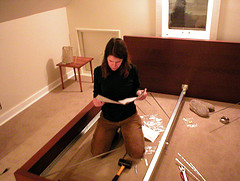
You know how you can be banging your head against a wall, trying to figure something out?
Then, you sleep on it, take a shower, or go for a walk and suddenly a solution pops into your head.
Have you ever wondered why this happens or how it works? So have I...and I don't know HOW it works, but I do know that we are practicing the exact same skill in qigong.
Let's look at how it works in qigong, why you might be missing it, and how you can begin to recognize some of the same signs in other areas of your life.
20 Repetitions
People often ask why we do qigong sets in certain numbers. Whenever I've heard Bruce Frantzis answer that question, he tells a story about these elaborate experiments they run in the Taoist monasteries, over generations, with control groups and varying repetitions, to see what the optimal number of repetitions for each exercise is. I always feel bad for the monks who spent their lives doing a few too many of each exercise.
But I think there's another reason to do somewhere around 20 reps of each exercises (in a typical qigong set). I tried to explain how each group of reps feels to me in this post.
In this context, what I want you to start to look for is the moment when, after a certain number of repetitionss, you cross a threshold where internal rhythms can take over. Your directed, intentional mind can flip from "doing" to "following."
In those moments when the solution to your problem finally dawns on you, don't you feel the same way? Your mind is open and the solution comes in. You're not bearing down on the problem with intention (and tension) the same way when you were trying to solve it.
Tension and Relaxation
Now, if these really are parallel processes, some interesting connections emerge.
It seems like you need a balance of doing and not doing, of tension and relaxation, or, as we've been trained to think in qigong, yin and yang.
For problem solving, most people focus on the yang moment of structure and intention, the active phase of "working to solve the problem." Then, when we figure it out in the shower, "out of nowhere," we beat ourselves up for not seeing it, or think we're stupid because now the solution is so obvious.
But qigong teaches us that the yang phase is necessary to set up the yin phase. You have the prime the process actively before you can relax into the passive phase where a solution can emerge.
How often have you approached a problem with the intention to solve it, then equally valued and created the space, time, and distance to let the yin phase of problem solving happen?
What if we trained to let this happen the same way we train dissolving and sense our bodies, energies, and minds in qigong? I know I could personally use more of this kind of practice.
Here are some more ideas on problem solving and letting solutions come to you:

Share this post
Twitter
Google+
Facebook
Reddit
LinkedIn
StumbleUpon
Pinterest
Email